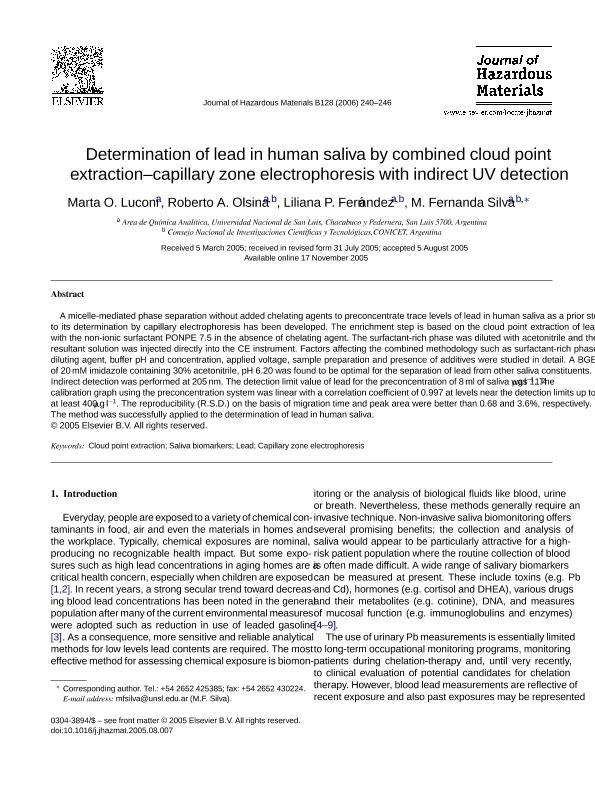Mostrar el registro sencillo del ítem
dc.contributor.author
Luconi, Marta Olga

dc.contributor.author
Olsina, Roberto Antonio

dc.contributor.author
Fernandez, Liliana Patricia

dc.contributor.author
Silva, María Fernanda

dc.date.available
2020-03-13T22:26:04Z
dc.date.issued
2006-02
dc.identifier.citation
Luconi, Marta Olga; Olsina, Roberto Antonio; Fernandez, Liliana Patricia; Silva, María Fernanda; Determination of lead in human saliva by combined cloud point extraction-capillary zone electrophoresis with indirect UV detection; Elsevier Science; Journal of Hazardous Materials; 128; 2-3; 2-2006; 240-246
dc.identifier.issn
0304-3894
dc.identifier.uri
http://hdl.handle.net/11336/99617
dc.description.abstract
A micelle-mediated phase separation without added chelating agents to preconcentrate trace levels of lead in human saliva as a prior step to its determination by capillary electrophoresis has been developed. The enrichment step is based on the cloud point extraction of lead with the non-ionic surfactant PONPE 7.5 in the absence of chelating agent. The surfactant-rich phase was diluted with acetonitrile and the resultant solution was injected directly into the CE instrument. Factors affecting the combined methodology such as surfactant-rich phase diluting agent, buffer pH and concentration, applied voltage, sample preparation and presence of additives were studied in detail. A BGE of 20 mM imidazole containing 30% acetonitrile, pH 6.20 was found to be optimal for the separation of lead from other saliva constituents. Indirect detection was performed at 205 nm. The detection limit value of lead for the preconcentration of 8 ml of saliva was 11.4 μg l−1. The calibration graph using the preconcentration system was linear with a correlation coefficient of 0.997 at levels near the detection limits up to at least 400 μg l−1. The reproducibility (R.S.D.) on the basis of migration time and peak area were better than 0.68 and 3.6%, respectively. The method was successfully applied to the determination of lead in human saliva.
dc.format
application/pdf
dc.language.iso
eng
dc.publisher
Elsevier Science

dc.rights
info:eu-repo/semantics/openAccess
dc.rights.uri
https://creativecommons.org/licenses/by-nc-sa/2.5/ar/
dc.subject
CLOUD POINT EXTRACTION
dc.subject
SALIVA BIOMARKERS
dc.subject
LEAD
dc.subject
CAPILLARY ZONE ELECTROPHORESIS
dc.subject.classification
Química Analítica

dc.subject.classification
Ciencias Químicas

dc.subject.classification
CIENCIAS NATURALES Y EXACTAS

dc.title
Determination of lead in human saliva by combined cloud point extraction-capillary zone electrophoresis with indirect UV detection
dc.type
info:eu-repo/semantics/article
dc.type
info:ar-repo/semantics/artículo
dc.type
info:eu-repo/semantics/publishedVersion
dc.date.updated
2019-11-25T18:20:58Z
dc.journal.volume
128
dc.journal.number
2-3
dc.journal.pagination
240-246
dc.journal.pais
Países Bajos

dc.journal.ciudad
Amsterdam
dc.description.fil
Fil: Luconi, Marta Olga. Universidad Nacional de San Luis. Facultad de Química, Bioquímica y Farmacia. Departamento de Química. Área de Química Analítica; Argentina
dc.description.fil
Fil: Olsina, Roberto Antonio. Consejo Nacional de Investigaciones Científicas y Técnicas. Centro Científico Tecnológico Conicet - San Luis. Instituto de Química de San Luis. Universidad Nacional de San Luis. Facultad de Química, Bioquímica y Farmacia. Instituto de Química de San Luis; Argentina
dc.description.fil
Fil: Fernandez, Liliana Patricia. Consejo Nacional de Investigaciones Científicas y Técnicas. Centro Científico Tecnológico Conicet - San Luis. Instituto de Química de San Luis. Universidad Nacional de San Luis. Facultad de Química, Bioquímica y Farmacia. Instituto de Química de San Luis; Argentina
dc.description.fil
Fil: Silva, María Fernanda. Consejo Nacional de Investigaciones Científicas y Técnicas. Centro Científico Tecnológico Conicet - Mendoza. Instituto de Biología Agrícola de Mendoza. Universidad Nacional de Cuyo. Facultad de Ciencias Agrarias. Instituto de Biología Agrícola de Mendoza; Argentina
dc.journal.title
Journal of Hazardous Materials

dc.relation.alternativeid
info:eu-repo/semantics/altIdentifier/url/https://www.sciencedirect.com/science/article/pii/S0304389405004644
dc.relation.alternativeid
info:eu-repo/semantics/altIdentifier/doi/http://dx.doi.org/10.1016/j.jhazmat.2005.08.007
Archivos asociados
